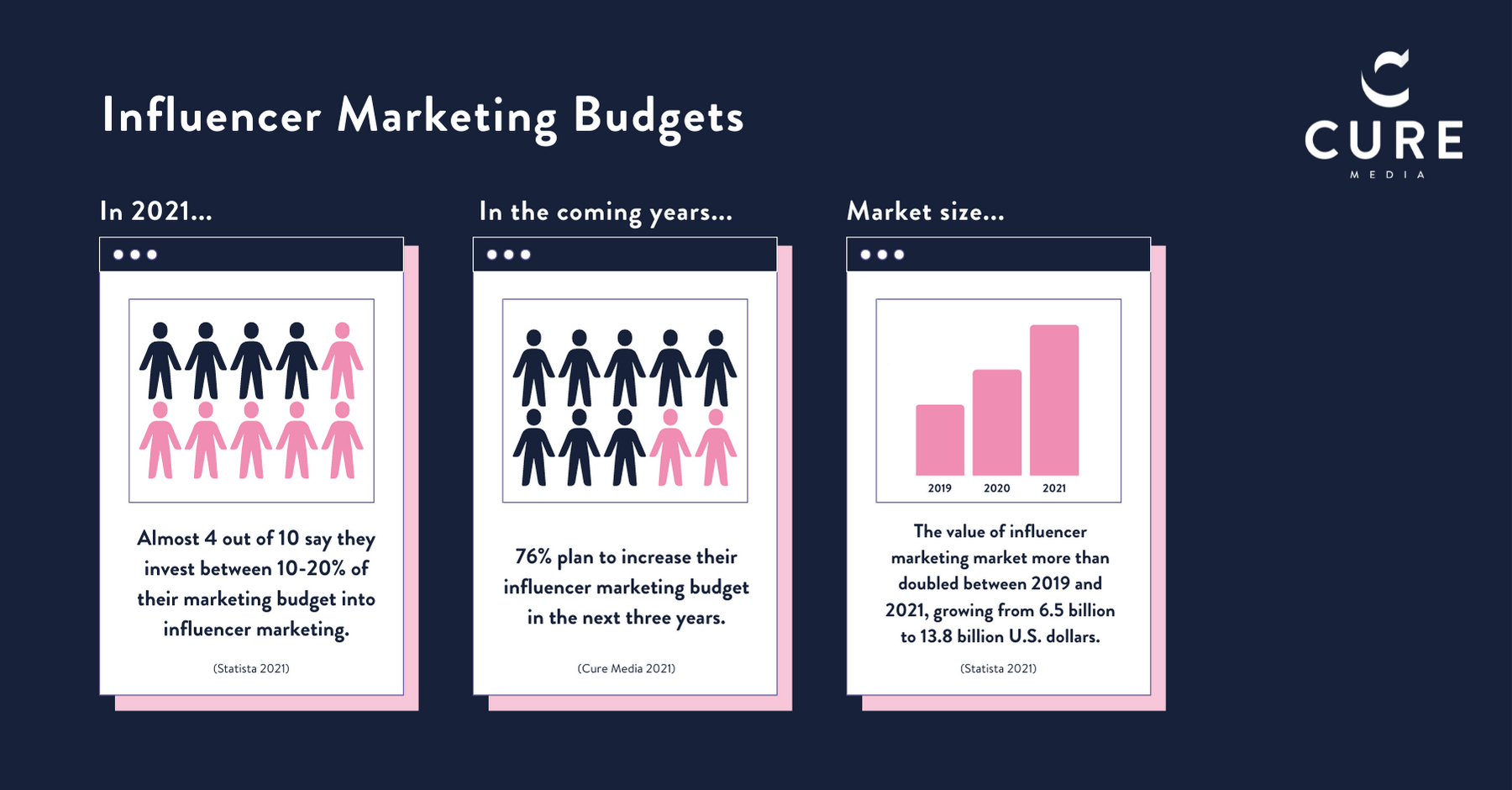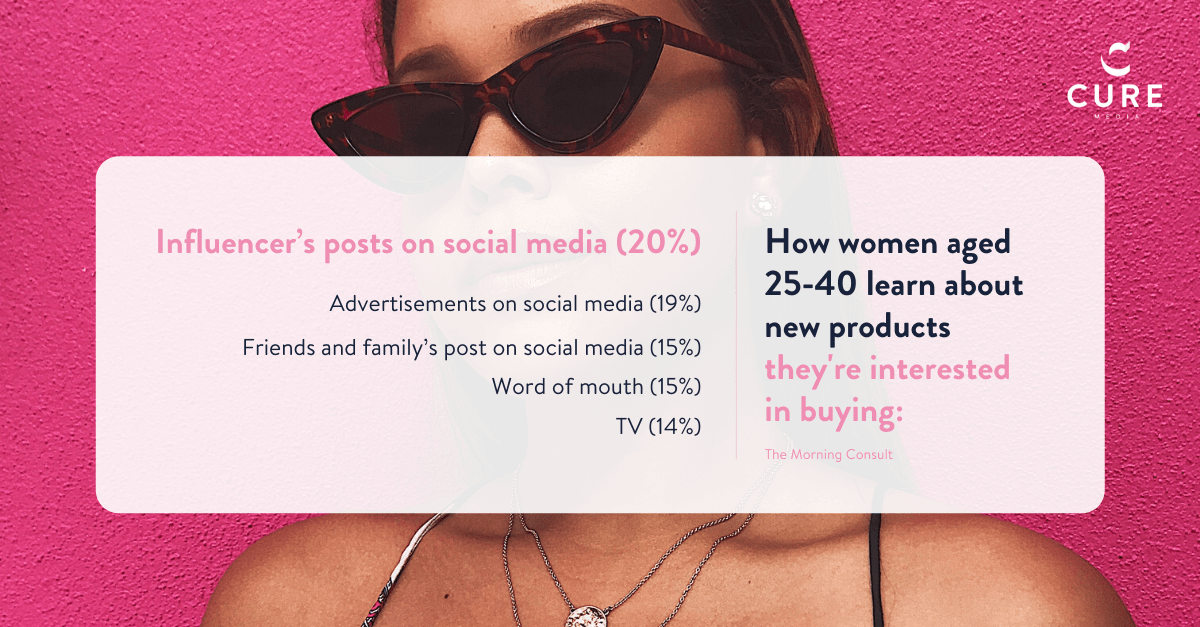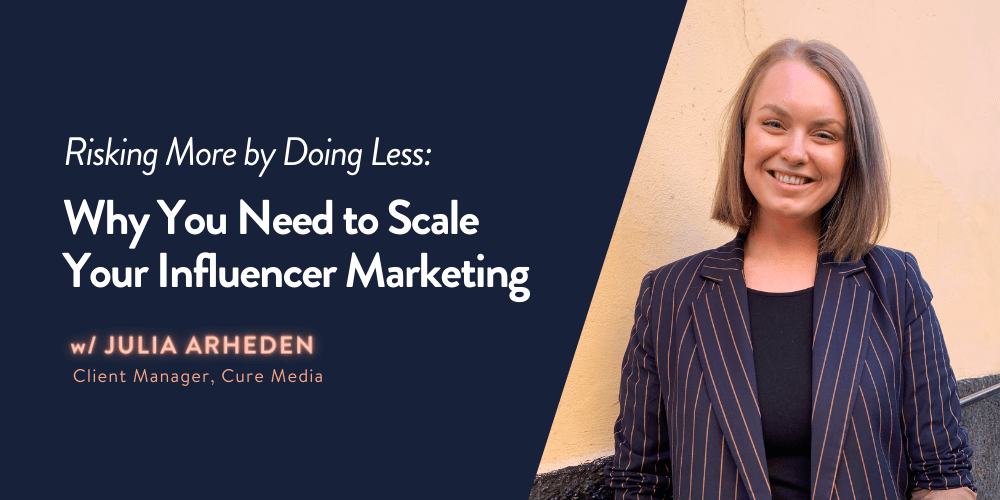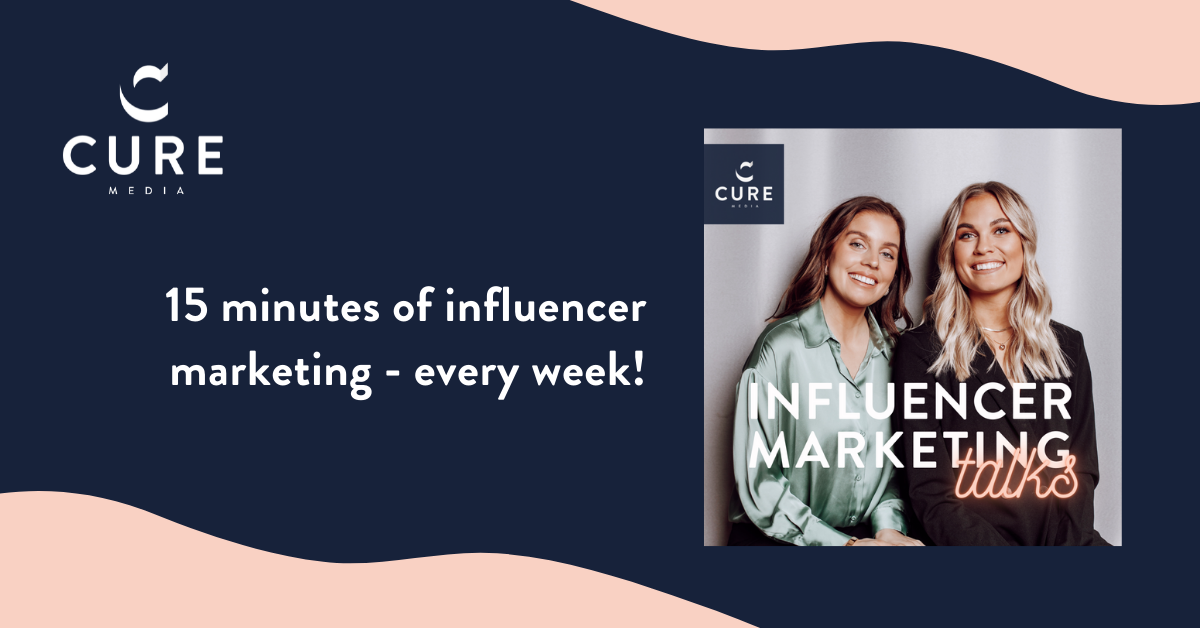With the continued growth of the influencer marketing industry, more and more companies are upping their budgets and looking to strengthen their influencer marketing activities.
Today, almost 4 out of 10 brands and agencies say they invest between 10-20% of their marketing budget into influencer marketing. But that figure is already on the move with 76% planning to increase their investment in influencer marketing over the next three years. So don’t risk getting left behind.
Scaling your influencer marketing
In this article, we had a chat with Julia Arheden, Client Manager at Cure Media.
“To me, these are super exciting times to be in this industry. Consumer behaviours, the way we shop and are influenced – it’s all changing so fast. Plus there are new platforms and features to consider which makes it super important to stay on your toes, be constantly up to date, curious and adaptable.” – Julia Arheden
Why you need to scale up your influencer marketing
Principally, the purpose of scaling up your influencer marketing is to get more out of the channel. It enables you to establish more touchpoints with your audience and communicate with a larger portion of them.
What does scaling up influencer marketing mean?
Let’s start from the beginning by defining what we’re talking about. Scaling up means growing your influencer marketing over time. This might mean increasing the number of influencers you work with or the frequency you work with them.
Let’s talk numbers
The extent to which you need to scale your influencer marketing will be unique to your business depending on the size and importance of your audience on any given platform, the size of your brand, and what kind of budget you’re working with. While ‘more’ is usually the most straightforward answer, we’ll do our best to provide a more succinct guideline.
A good benchmark to have in mind is to allocate roughly 10-20% of your marketing budget to influencer marketing. If you’re working within fashion, health and beauty, or interior design, you probably need to be on the higher end of this range. However, if we refer back to the statistic from the beginning, that 76% of brands and agencies are planning to increase their influencer marketing budgets over the next three years, then we can see that this range should be considered a jumping off point and not the end goal.

Of course, we know it’s a gradual process and you can’t go from 0 to 100 in one go, but to compete in the modern marketplace that process should already be underway. It bears remembering that digital natives within industries like fashion, beauty, interior, sports and lifestyle are already spending significantly more within the channel than their more traditional peers. If we look at NA-KD as an example – one of fastest growing companies in Europe, NA-KD has cemented itself as a leader in fashion and e-commerce. And in 2020 alone they spent €10 million on influencer marketing. Since their launch in 2016 they have worked with over 100,000 influencers.
Media consumption over the last couple of years
Consumer behaviour and media consumption trends have changed enormously over the past five years. It is a completely different landscape today. And it’s changing continuously, which makes it a challenge for marketers to keep up and adapt.
The biggest and most universal change, spanning all demographics and regions, is that we are spending a tremendous amount of time on our phones and on social media. There is even an expression called ‘tech neck’ now, which describes the pain you feel in your neck from spending too long craned over your phone or computer screen. Sound familiar? Sure does to me!
While we could spend hours unpacking the various and intricate differences between each and every user group, let’s boil it down to the audiences that I have the most insights about: Gen Z and millennial women. As a group, we are moving more and more towards being mobile-first, and particularly among the younger members of this market, this shift isn’t happening, it has already happened.
The move from traditional retail to eCommerce has obviously accelerated with the pandemic. But not only are consumers doing more online shopping, they are also increasingly reliant on social media when it comes to researching or drawing inspiration on what to buy and from which brands. Further to this, many are actually starting to make their purchases directly within the social platforms, as with Instagram’s Checkout feature.
Find out more about the social media trends for 2022.
How is this changing consumer behaviour connected to influencer marketing?
These shifts in consumer behaviour are obviously huge for the influencer marketing industry. A change in shopping habits like this means that consumers are relying on influencers to a greater extent than ever before to offer inspiration and to help them navigate the eCommerce jungle.
Looking at the Gen Z and millennial female audience, their top source for finding products to purchase is influencers’ posts on social media, according to a study by Morning Consult.

This fact alone is argument enough to scale up your influencer marketing. But together with the knowledge that we are spending more time on social media plus the emerging shift from traditional retail to eCommerce to social commerce – I think it’s impossible to dismiss influencer marketing as a campaign-based silo channel. Instead, you have to incorporate it into your overall marketing strategy, just like you would your other marketing channels. This way you will not only be more effective, but you’ll also be better equipped to track the results and spillover effects that influencer marketing has on your brand and bottom line as a whole.
Why isn’t it enough to do a few seasonal campaigns and one-offs? Why do brands need to scale up?
Let’s say that you’re putting a lot of budget and resources into a Black Friday campaign. Your team has done an excellent campaign with a cool message and a perfect influencer and content strategy. Your audience will see this in their feed, maybe even give it a second glance. In the best case scenario, they get the message and interact. But the more likely outcome is that they just keep on scrolling – right into your competitor’s content three posts later.
Your competitor, on the other hand, hasn’t banked on a single campaign to get the job done. They have months’ of posts ready to roll. They appeared in your audience’s feeds yesterday and they’ll appear in them tomorrow, next week and next month. While your post comes and goes with the Black Friday sales your competitor has created a sustained presence, and with that brand recognition and a much higher chance of conversion.
My point is that there is a huge risk when putting all of your eggs in one basket and spending such a large chunk of your budget on a single campaign – particularly when it likely won’t even be that effective. Whereas with an always-on strategy, you can of course add campaigns on top of them to get a boost, but those campaigns will have a much better impact if your audience already knows your brand and is used to seeing your collaborations with influencers.
What are the risks if you work on a small scale?
There are several risks, but I’d say the main ones are:
1. You can’t evaluate the outcome
It is hard, or almost impossible, to accurately evaluate your outcome when you’re working on a small scale. Limiting your output is not going to dramatically boost sales numbers, it’s not going to generate explosive brand awareness and preference among consumers, and it’s not going to contribute to your other marketing channels in a way that is measurable.
The risk is that your results are too small or scattered to be accurately measured and you therefore mistakenly assume that there aren’t any, likely leading to the redirection of budget and the closure of your influencer marketing strategy. With this, you miss out on utilising the channel your audience actually spends the most time in and are turning to for shopping inspiration.
Instead, adopt an always-on approach by working over several months (preferably years!) to maintain a consistent presence in your audience’s lives and feed through people that they actively follow and trust.
2. It will be difficult to see patterns
If you choose to work on a small scale with two or three influencers, it will be very hard to pinpoint which influencers really work for your brand and which do not. Your testing pool is simply too small. If, on the other hand, you work with several influencers you can easily see patterns that indicate which accounts are contributing and which content approaches deliver and which categorically do not. Recognising and responding to these patterns to continuously optimise and improve your influencer marketing is key to success within the channel.
3. You will not be top of mind when it’s time for a purchase
Never before have this many brands allocated this amount of resources to their online channels, meaning that the media noise is harder than ever to break through. Even if you’ve worked really hard to set up a fantastic one-off ad, the reality is that your audience will be exposed to conflicting commercial messages only seconds later, reducing the likelihood that your brand will be top of mind when it’s time to purchase. If you’re not working at scale with influencer marketing your message will be lost in the crowd and you simply won’t have the posting frequency to extract it.
In summary, scaling up will make it possible to see clearer results in not only influencer marketing but also in your other marketing channels. You will have the opportunity to track performance patterns and optimise accordingly to ensure that you are best positioned to cut through the noise and catch your target audience’s attention.
What are the benefits of scaling your influencer marketing?
When you scale, you’ll have more data at hand to determine what works in terms of influencer selection, content, message, channel, format, offer etc. And the more data you have, the easier it is to make intelligent adjustments and achieve better results faster. Then, once you have this optimised, data-informed influencer strategy, you will reach a large enough part of your audience to actually see measurable results and enjoy greater clarity around how influencer activations affect your other marketing channels.
Growth is also an important aspect. When scaling up, you’ll reach new prospects quicker, giving you actionable insights on how they interact with your brand, what triggers they respond to. This is knowledge that, with influencers present in your consumers’ feeds at all the time, promoting and discussing your brand, you can deploy to target and refine your approach, distinguishing your brand from the masses competing for each prospect’s attention.
Finally, with a brand’s commitment to inclusivity being an important part of purchasing decisions for Gen Z and Millennials, scaling up your influencer marketing simply gives you more scope to highlight the myriad amazing influencers operating in the industry today, influencers that come from a range of backgrounds and cultures and who have different perspectives or disabilities. This is a critical step for brands to take in their marketing and communications for 2022, and one for which influencer marketing, with the deeply personal and human touch it affords, is a perfect fit for.
Thanks Julia for sharing your knowledge on the why’s and how’s, and the do’s and don’ts of scaling influencer marketing. It was a pleasure to chat with you! If you want to connect with Julia, you can find her here.
Want to learn more about all things influencer marketing? Don’t miss our podcast! Each week, we cover topics around digital and social media to help you take your marketing strategy to the next level. Also, join the conversations with topic experts from the industry!



